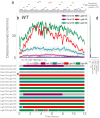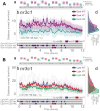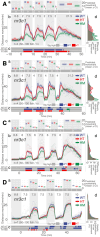Key HPI axis receptors facilitate light adaptive behavior in larval zebrafish
- PMID: 38565594
- PMCID: PMC10987622
- DOI: 10.1038/s41598-024-57707-6
Key HPI axis receptors facilitate light adaptive behavior in larval zebrafish
Abstract
The vertebrate stress response (SR) is mediated by the hypothalamic-pituitary-adrenal (HPA) axis and contributes to generating context appropriate physiological and behavioral changes. Although the HPA axis plays vital roles both in stressful and basal conditions, research has focused on the response under stress. To understand broader roles of the HPA axis in a changing environment, we characterized an adaptive behavior of larval zebrafish during ambient illumination changes. Genetic abrogation of glucocorticoid receptor (nr3c1) decreased basal locomotor activity in light and darkness. Some key HPI axis receptors (mc2r [ACTH receptor], nr3c1), but not nr3c2 (mineralocorticoid receptor), were required to adapt to light more efficiently but became dispensable when longer illumination was provided. Such light adaptation was more efficient in dimmer light. Our findings show that the HPI axis contributes to the SR, facilitating the phasic response and maintaining an adapted basal state, and that certain adaptations occur without HPI axis activity.
Keywords: GAM (generalized additive models); GR (glucocorticoid receptor); Light adaptation; Light assays; Stress response; Zebrafish.
© 2024. The Author(s).
Conflict of interest statement
The authors declare no competing interests.
Figures








Update of
-
The canonical HPA axis facilitates and maintains light adaptive behavior.Res Sq [Preprint]. 2023 Sep 6:rs.3.rs-3240080. doi: 10.21203/rs.3.rs-3240080/v1. Res Sq. 2023. Update in: Sci Rep. 2024 Apr 2;14(1):7759. doi: 10.1038/s41598-024-57707-6. PMID: 37720015 Free PMC article. Updated. Preprint.
Similar articles
-
The canonical HPA axis facilitates and maintains light adaptive behavior.Res Sq [Preprint]. 2023 Sep 6:rs.3.rs-3240080. doi: 10.21203/rs.3.rs-3240080/v1. Res Sq. 2023. Update in: Sci Rep. 2024 Apr 2;14(1):7759. doi: 10.1038/s41598-024-57707-6. PMID: 37720015 Free PMC article. Updated. Preprint.
-
Novel zebrafish behavioral assay to identify modifiers of the rapid, nongenomic stress response.Genes Brain Behav. 2019 Feb;18(2):e12549. doi: 10.1111/gbb.12549. Epub 2019 Jan 15. Genes Brain Behav. 2019. PMID: 30588759 Free PMC article.
-
Impaired negative feedback and death following acute stress in glucocorticoid receptor knockout Xenopus tropicalis tadpoles.Gen Comp Endocrinol. 2022 Sep 15;326:114072. doi: 10.1016/j.ygcen.2022.114072. Epub 2022 Jun 10. Gen Comp Endocrinol. 2022. PMID: 35697317
-
Early life nutrient restriction affects hypothalamic-pituitary-interrenal axis gene expression in a diet type-specific manner.Gen Comp Endocrinol. 2024 Jun 1;352:114490. doi: 10.1016/j.ygcen.2024.114490. Epub 2024 Mar 8. Gen Comp Endocrinol. 2024. PMID: 38460737 Review.
-
Dissection of glucocorticoid receptor-mediated inhibition of the hypothalamic-pituitary-adrenal axis by gene targeting in mice.Front Neuroendocrinol. 2015 Jan;36:150-64. doi: 10.1016/j.yfrne.2014.09.002. Epub 2014 Sep 27. Front Neuroendocrinol. 2015. PMID: 25256348 Free PMC article. Review.
Cited by
-
Zebrafish mecp2 null-mutation increases anxiety and cortisol levels but no change in adult social preference and larval chemically-induced hyperlocomotion.BMC Neurosci. 2025 Jul 1;26(1):38. doi: 10.1186/s12868-025-00946-8. BMC Neurosci. 2025. PMID: 40596833 Free PMC article.
References
MeSH terms
Substances
Grants and funding
LinkOut - more resources
Full Text Sources
Research Materials

